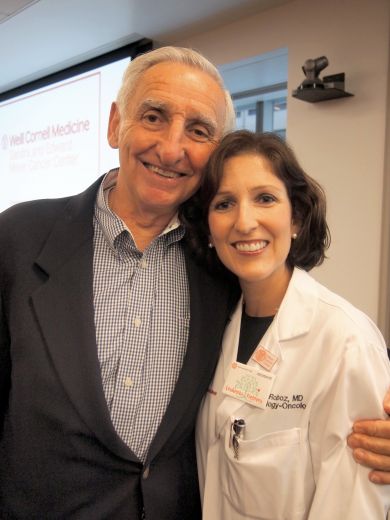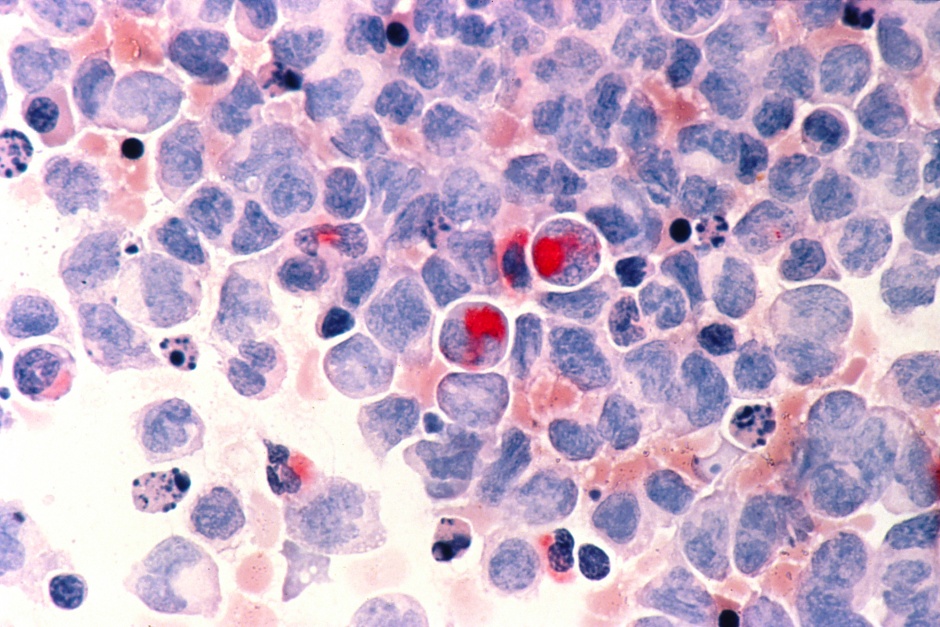Remission without admission
It was a day he wasn’t sure he’d see. Diagnosed in 2014 with an aggressive form of blood cancer -- acute myeloid leukemia (AML) -- and told to “get your affairs in order,” Ralph Hills had little hope of reaching his 72nd birthday, never mind his 73rd.
But this September, the computer services business owner was able to celebrate with wife Dorcas and daughter Cari, thanks to a revolutionary new treatment that put his cancer into remission – without ever being admitted to the hospital.
Hills is an early beneficiary of a clinical trial at Weill Cornell Medicine/NewYork-Presbyterian of a drug targeting mutations in IDH1 and IDH2. These are proteins that produce the metabolite AKG, which is required for the normal function of proteins that cause bone marrow stem cells to form blood cells. In AML patients with mutations of the IDH1/2 gene, the mutant IDH proteins aberrantly generate a poisonous “oncometabolite” compound called 2HG that blocks the process of blood development from stem cells.
“If we could prevent mutant IDH1/2 from making 2HG, we could restore the function of AKG dependent proteins, and this would cause the leukemia cells to now develop into fully mature blood cells instead of remaining stuck at an immature stage of development ” said Ari Melnick, M.D., the Gebroe Family Professor of Hematology and Oncology, whose lab showed how mutant IDH proteins cause leukemia, in 2010.
The fateful call
Hills was placed on the trial by oncologist Gail Roboz, M.D., who offered him a slot at literally the eleventh hour.
“On a Sunday evening, 12 hours before my chemo was scheduled to start, Dr. Roboz called us at home and asked if I would consider changing my treatment plan,” Hills said. “I was told that very recent research has differentiated AML mutations and might match a patient to a new medicine to destroy leukemia cells. So my choice was an unknown trial drug versus chemo and a short life span. We did not hesitate.”
It took five months for the drug to do its job, and it was a rough time.
“I was terribly sick, sleeping almost 24 hours a day for five months, barely mobile, unable to take in any food, losing 45 pounds and fighting side effects from preventive antibiotics. But still, being alive longer than expected restored some hope,” Hills said. “And except for trips to New York every two weeks for tests, I was at home, taking a daily pill, never in a chemo center.”
The deadly leukemia cells began to disappear, and healthy blood cells and platelets grew in their place.
“In October 2015, Dr. Roboz politely cut our appointment short saying, ‘please excuse me, I have sick people to see.’ Such wonderful words to hear,” Hills said.
Within another five months, most of the side effects subsided and his strength returned.
“2015 was the worst year of my life, but also the luckiest. I was just hours from non-cure chemo treatments and instead qualified into a trial,” Hills said. “I continue to take the trial drug every day and we count our blessings.”
"I feel I owe every day to Dr Roboz and her team."
Remarkable remissions
Hills’s response to the drug has been mirrored in other patients.
“They are well tolerated pills, and the side effects are easier than chemotherapy,” Roboz said. “In some cases, it can result in single-agent remission, and the response appears durable for months.”
The treatment would be welcome news for a disease that is becoming increasingly common, with poor outcomes, especially for patients more than 60 years of age, who represent the vast majority. Cure rates in these individuals, who typically do not tolerate high-dose chemotherapy and stem cell transplantation, are below 20 percent and have not been improved significantly in the past four decades -- the drug identified in 1968 as a “useful agent” is still the main treatment.
“The problem is that cancer cells are experts at staying alive. You hit them with one drug and they are like New York-quality cockroaches – they keep coming back,” Roboz said.
Roboz said results of the experimental drug have been so encouraging that the team has filed for accelerated FDA approval in hopes of making it a primary treatment for those with mutations of the gene, which occurs in approximately 10-40 percent of patients.
It may not be a long-term cure, however, so trials combining it with other drugs are currently underway.
But it’s a risk Hills has been happy to take.
“I am lucky, but also proud, to be in the testing that accelerated this application to the FDA, and may help many others soon.”
“I recently had the second birthday we had not expected to reach,” Hills added. “For me, for my family and friends, every day is a bonus.”




